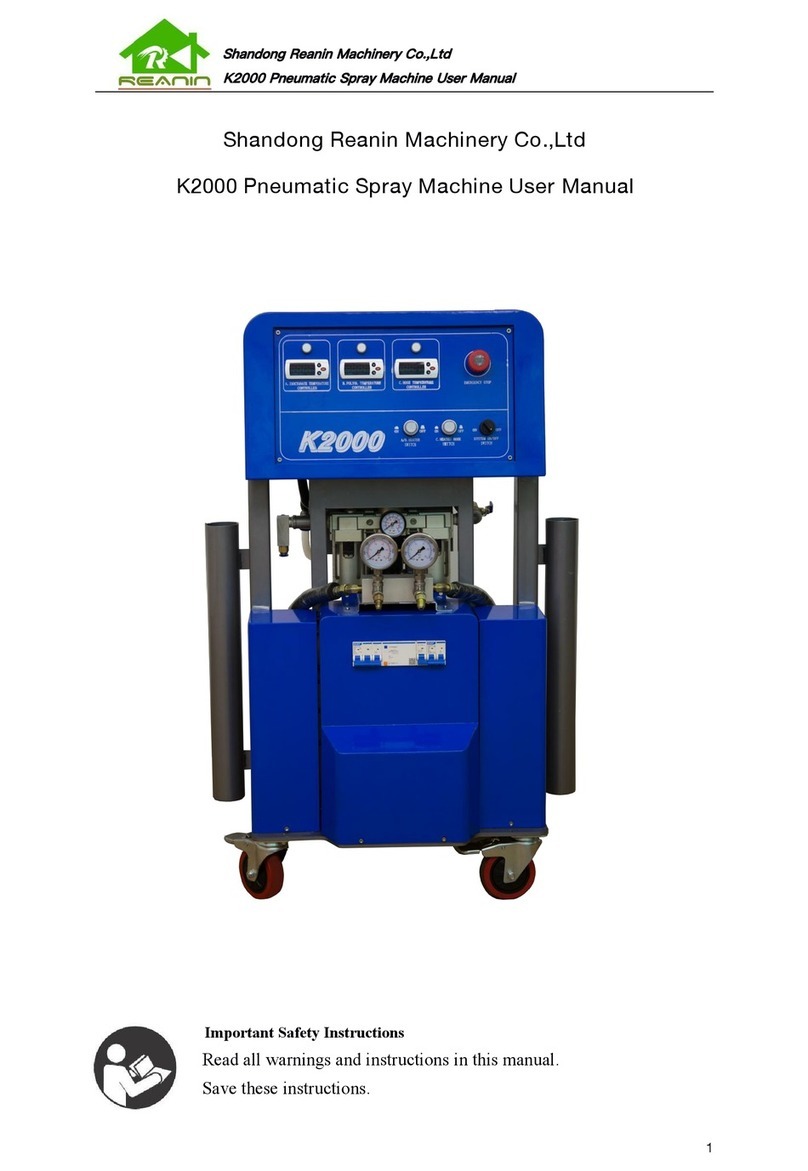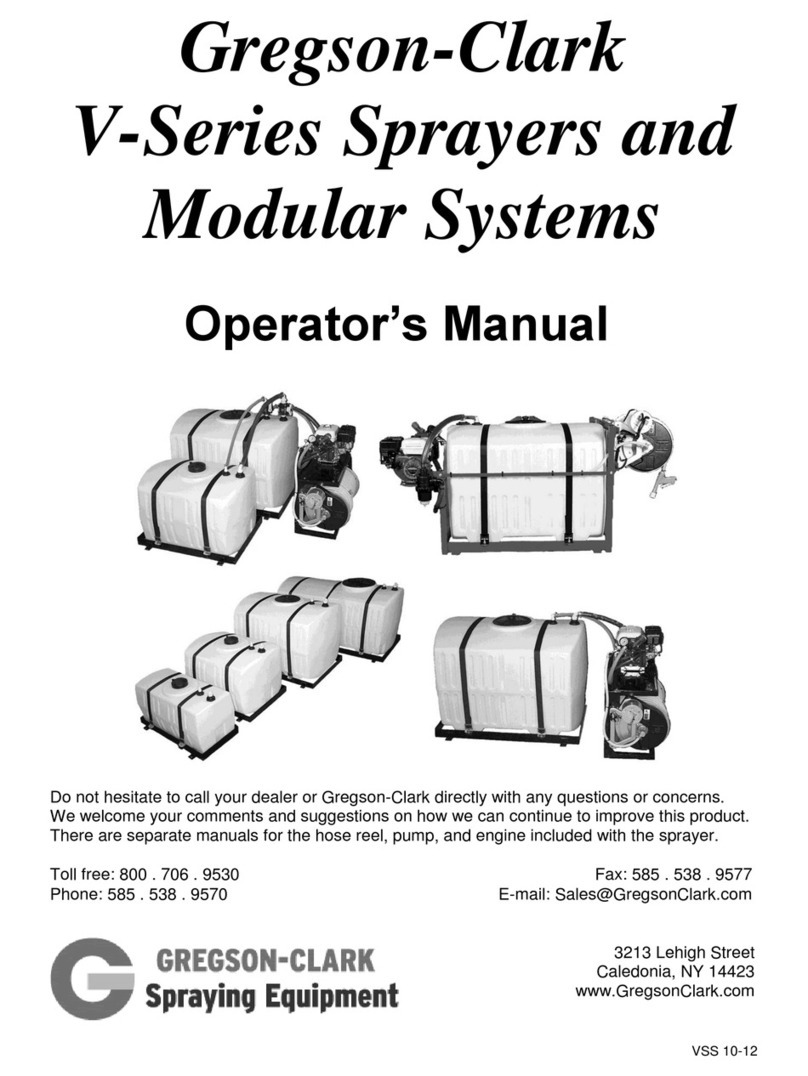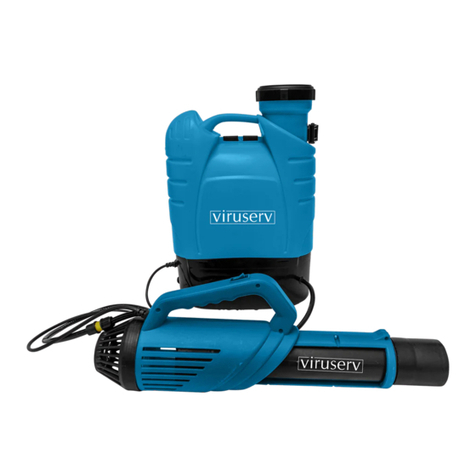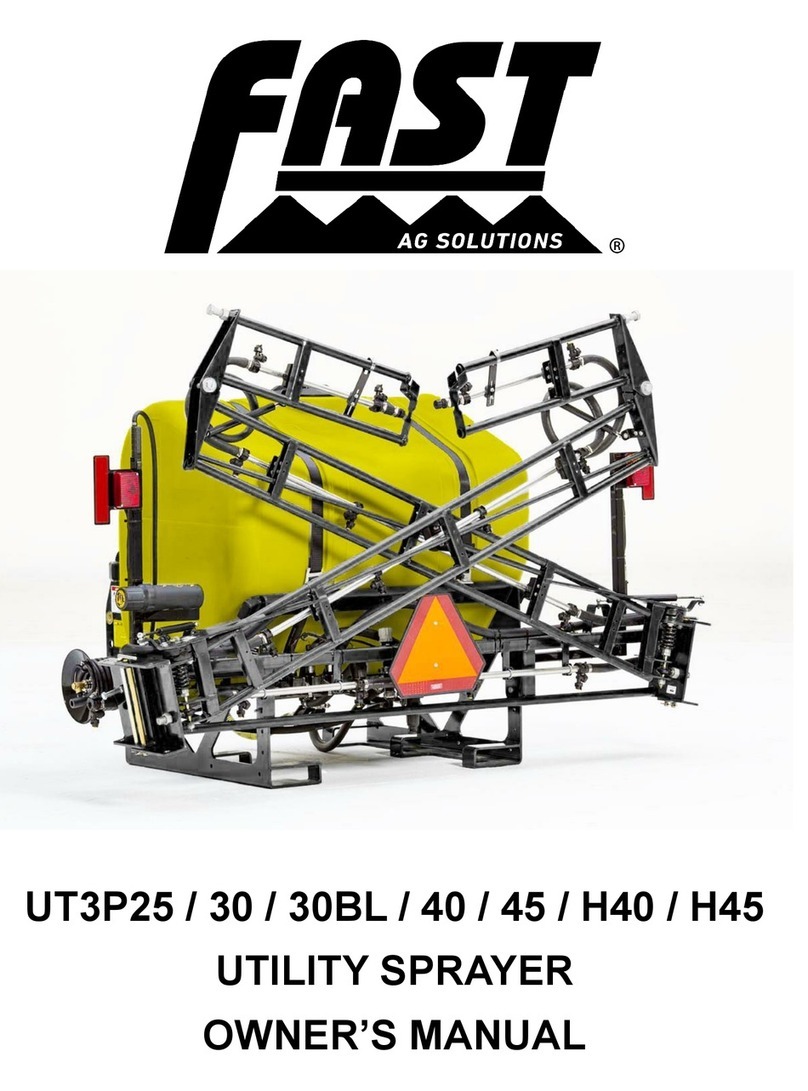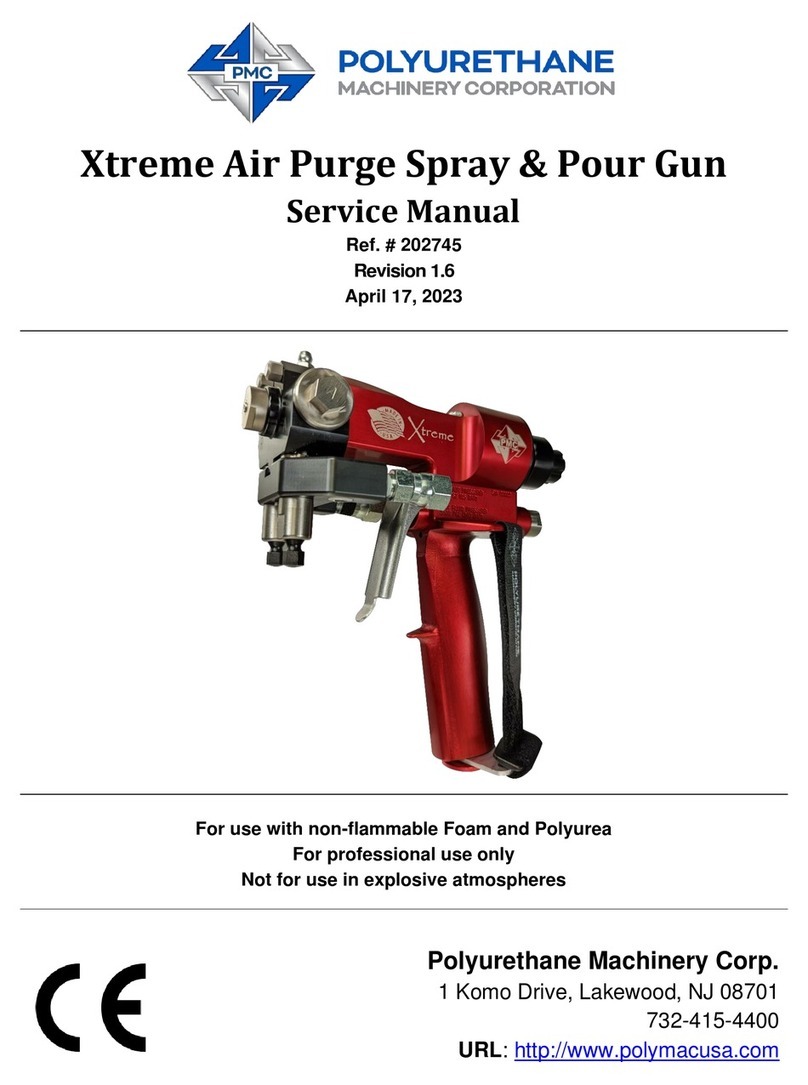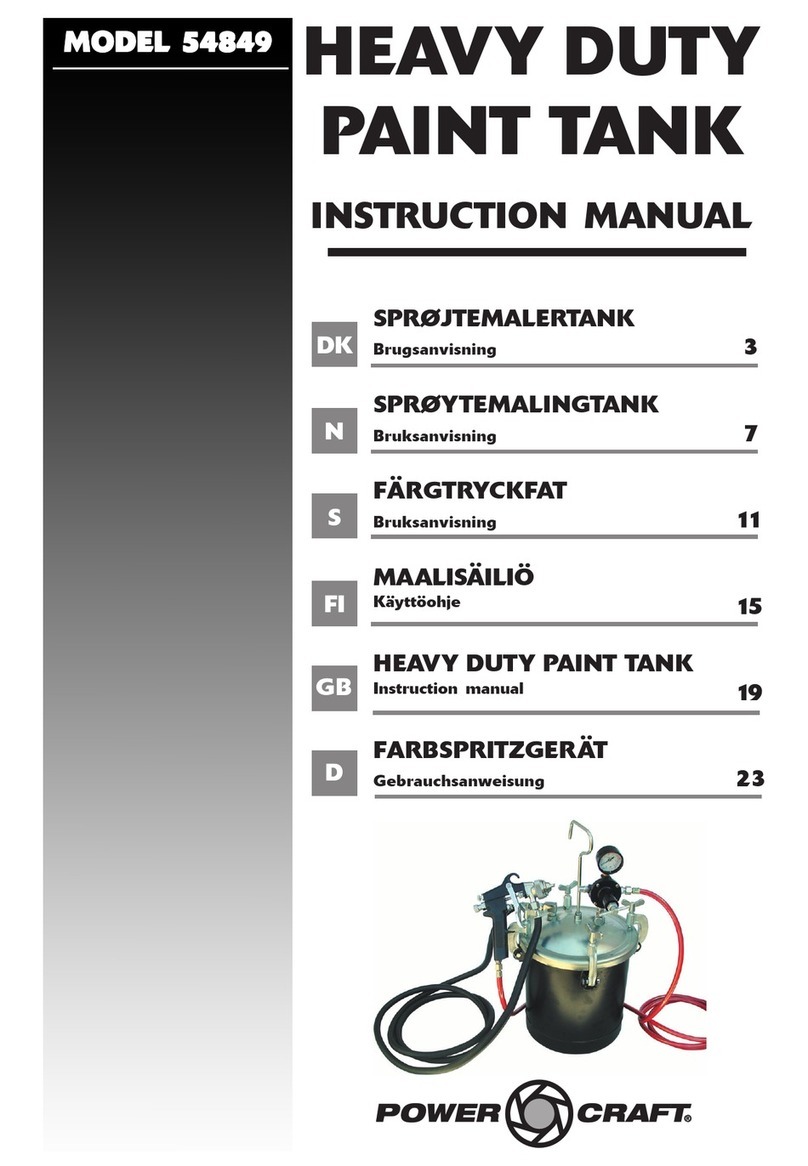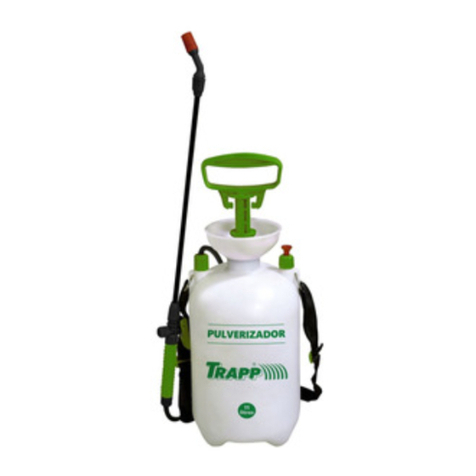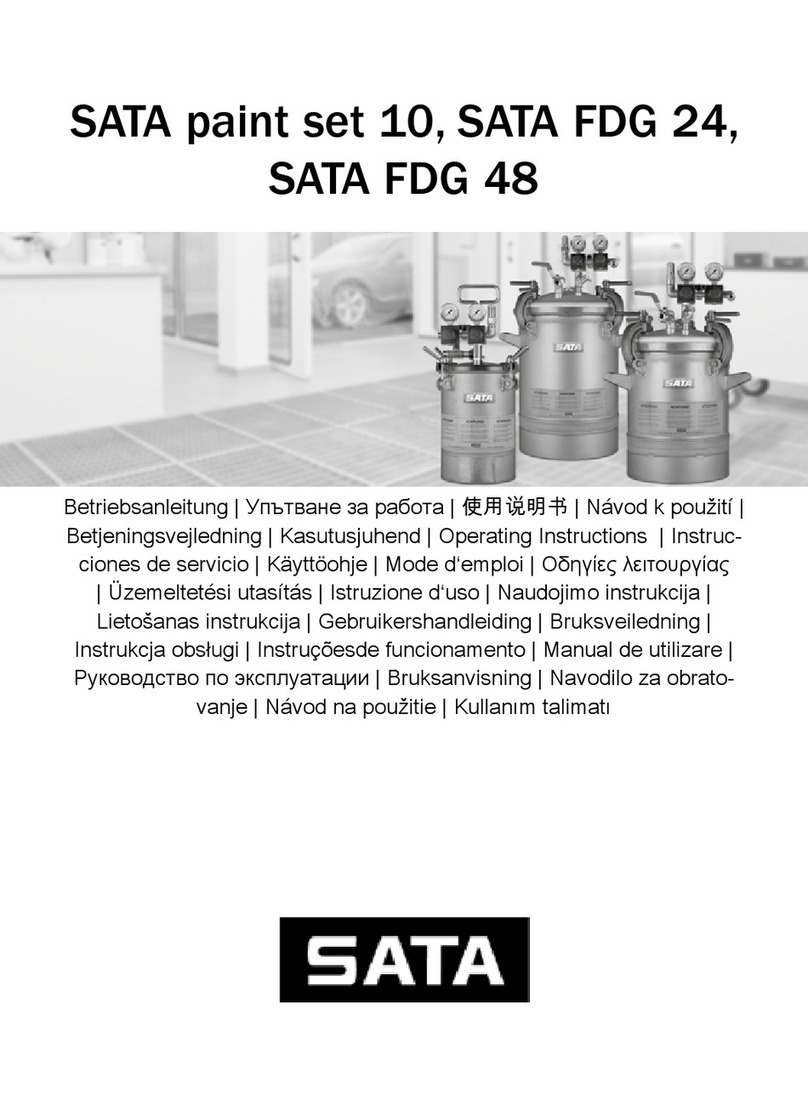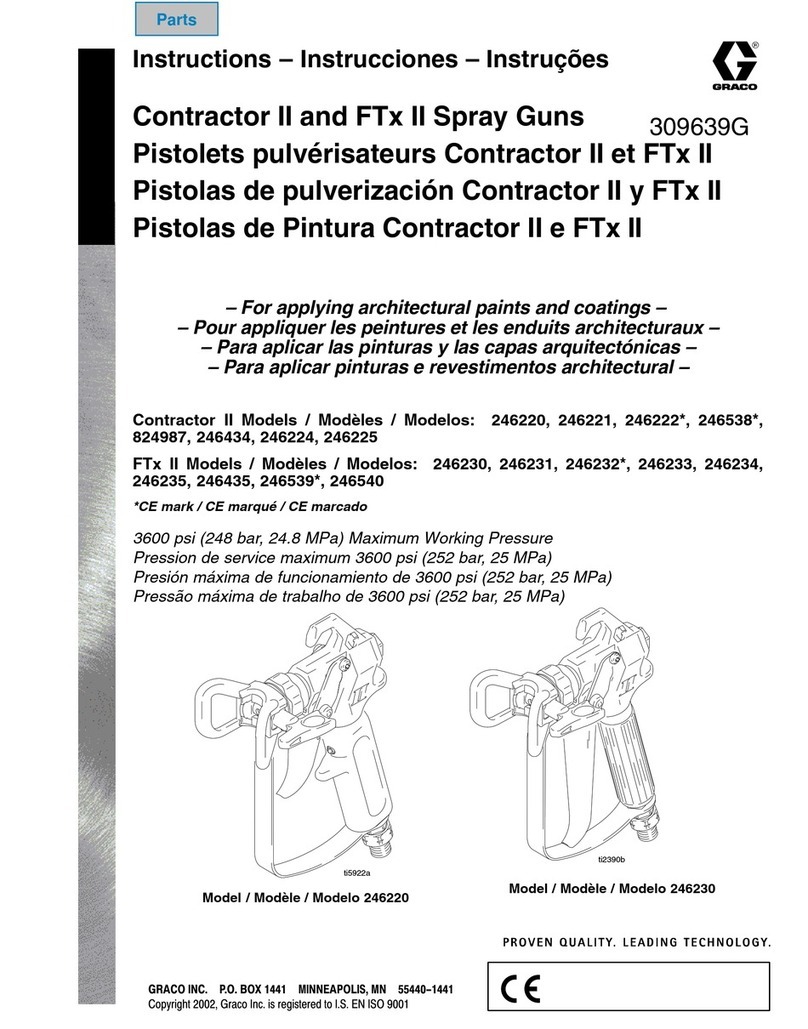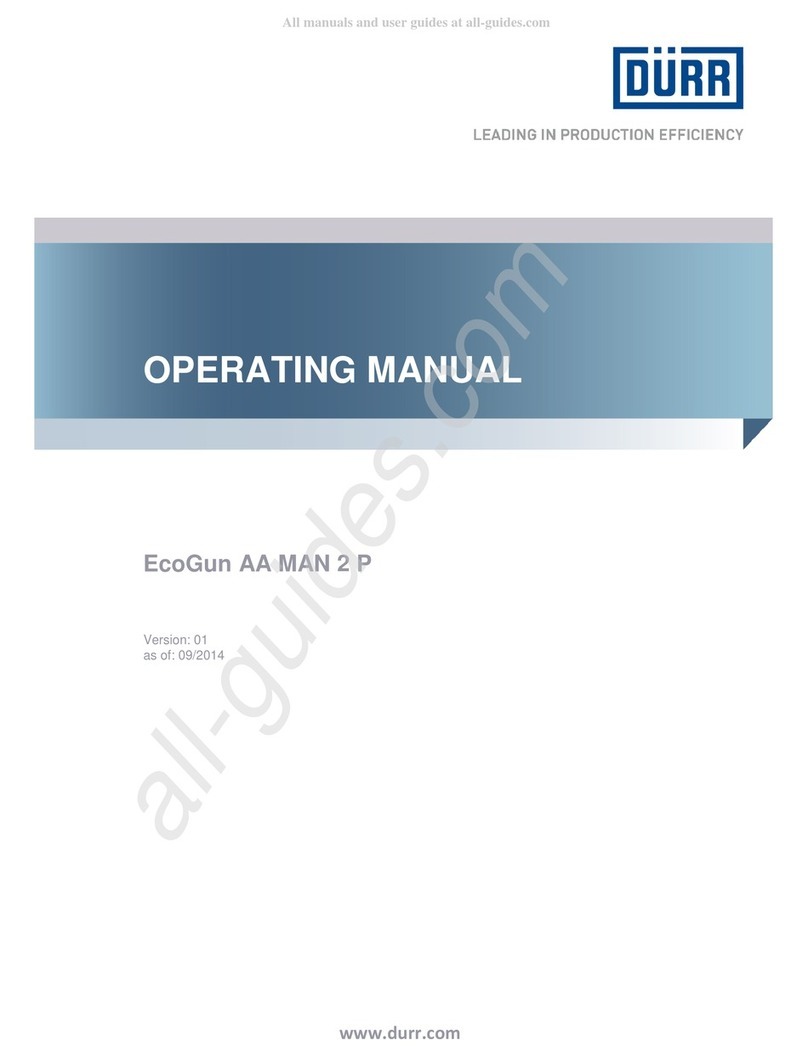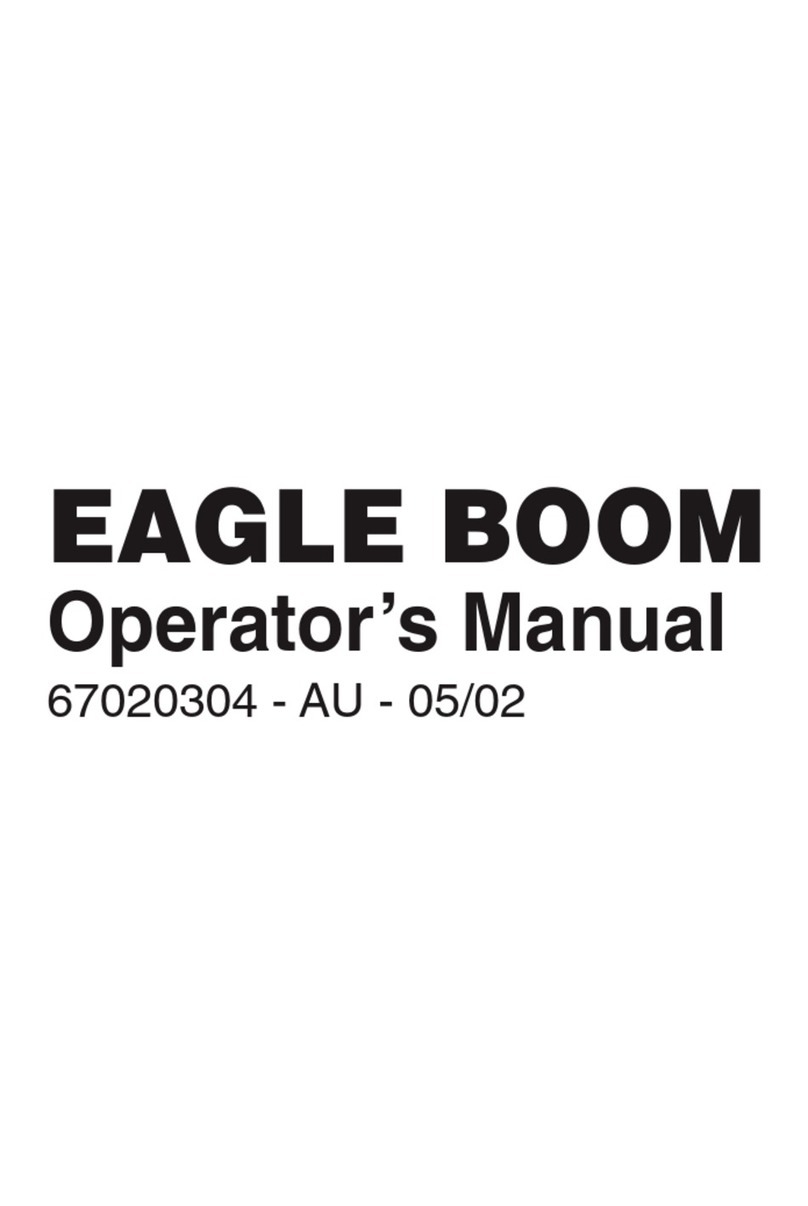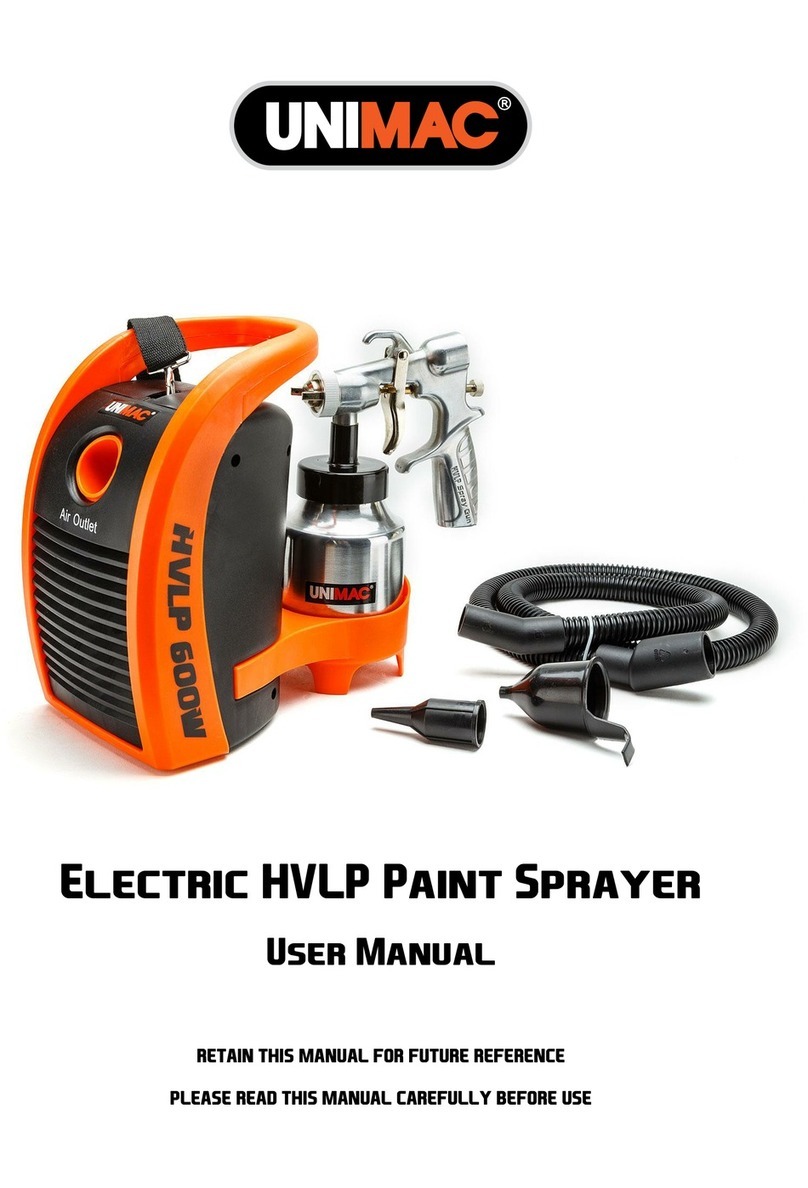Smith Performance Sprayers Industrial & Contractor Series User manual

Do Not Return This Sprayer To The Store
For Help, Information or Parts, Call : 1-800-311-9903
The Fountainhead Group, Inc.
23 Garden St., New York Mills, NY 13417
1-800-311-9903
www.TheFountainheadGroup.com
www.smithperformancesprayers.com
CAUTION: Read and follow all instructions
Manual No. 183280
Rev A: 10/27/16
ECN16-078
5 1/2”X 8 1/2”Booklet
Use and Care Manual
Acid Compression Sprayer
Industrial and Contractor Series
Acid
#190449

Do not return sprayer to store, if you experience problems or have questions contact
our toll free Customer Service Center, M-F 8A.M. - 5P.M., EST, at 1-800-311-9903, or
SAFETY PRECAUTIONS
• Read owner’s manual completely before operating this sprayer.
• Always use goggles, gloves, and protective clothing when using sprayer. Refer to the appropriate
technical bulletin for the chemical being sprayed for additional protective clothing required.
• Read and follow all instructions and cautions on label, material safety data sheets and technical bulletins
of products used in this sprayer.
• Never use ammable liquids, chlorine, bleach, hot water, caustics or other corrosive solutions or heat,
pressure or gas producing chemicals in the tank for the Acid Series sprayer.
• Do not leave sprayer in the sun when not in use.
• Spray when air is calm to prevent drift of chemicals.
• Do not use sprayer near open ame or anything that could cause ignition of the spray.
• Always inspect hose and all hose connections before each use. A damaged hose, or loose hose
connection can result in unintended exposure to the pressurized chemical, resulting in serious injury or
property damage.
• Do not lift or carry sprayer by the hose, shut-o valve, or extension. Carry by pump handle only,
making sure handle is properly locked in place before lifting.
• Do not pressurize with any mechanical device such as an air compressor, since this can create a
dangerous pressure level and bursting of parts resulting in serious injury. Only use original pump.
• Do not store chemicals in this tank.
• Always release pressure when sprayer is not in use and before removing pump from tank.
• Do not stand with face or body over top of tank when pumping or loosening pump, to prevent pump or
solution from striking you, resulting in serious injury.
• Clean and rinse sprayer thoroughly after each use.
• Never attempt to alter sprayer from original condition.
• Always use replacement parts from original manufacturer.
• Keep the sprayer and all chemicals out of the reach of children.
• When mixing muriatic acid or acid stain with water, always slowly add acid to water to minimize
heat generation and spattering. NEVER ADD WATER TO ACID. A reaction can occur causing the
liquid to expand rapidly and splash out of the sprayer.
WARNING
The sprayer is operated with liquid under pressure. Failure to observe caution and to follow instructions
for operating and cleaning can cause tank, hose and other parts to be weakened and rupture under
pressure. This can result in serious injury from high pressure discharge of liquids or forcible ejection of
parts. Do not use ammable materials in any sprayers covered by this manual. Material could ignite or
explode, causing serious injury and/or possible death. For safe use of this product, you must read and
follow all instructions before use.
TEST SPRAYER WITH WATER BEFORE USING ANY CHEMICALS.
CAUTION
Always empty, clean and dry tank, pump system, shut-o, hose, and extension after each use. FAILURE TO
DO SO MAY WEAKEN SPRAYER COMPONENTS, CAUSING COMPONENTS TO RUPTURE WHEN PRESSURIZED.
Additionally, FAILURE TO CLEAN AND PROPERLY MAINTAIN YOUR SPRAYER WILL VOID MANUFACTURER’S
WARRANTY.
WARNING
ALWAYS CLEAN THE SPRAYER AND SHUT-OFF THOROUGHLY AFTER EACH USE
OR WHEN CHANGING APPLICATIONS AS DESCRIBED IN THE CLEANING SECTION.
FAILURE TO COMPLETELY CLEAN MAY CAUSE CROSS-CONTAMINATION.
Page 2

Page 3
SM II
Assemble Extension, Shut-O & Nozzle
1. Install the extension onto the shut-o
assembly and tighten the nut securely.
(See Figure C)
2. Install selected nozzle onto the end of the
extension and tighten securely. (See Figure D)
ASSEMBLY INSTRUCTIONS
Assemble Hose To Tank
IMPORTANT: Do not attempt to heat or alter hose,
hose nut, or barb prior to assembly.
1. Align hose barb tabs, push hose barb into tank
until it stops (See Figure A).
2. Slide hose nut into place and turn clockwise to
tighten. (See Figure B).
NOTE: Do not use tools to tighten hose nut.
Figure A Figure B
Figure C Figure D
NOTE: BRASS NOZZLES CAN NOT BE USED ON ACID SPRAYERS.
80° FAN .07 GPM #4 GREEN
80°
80°
80°
80°
SPRAY
ANGLE: SPRAY
PATTERN:
FAN
FAN
FAN
FAN
FLOW
RATE:
.10 GPM
.13 GPM
.10 GPM
.20 GPM
COLOR
#6 RED
#10 BLACK
#8 GRAY
#12 BROWN
30° FAN .15 GPM
SPRAY
ANGLE: SPRAY
PATTERN: FLOW
RATE:
70° FAN .25 GPM
SPRAY
ANGLE: SPRAY
PATTERN: FLOW
RATE:
RED HIGH VOLUME
FAN NOZZLE USES: YELLOW LOW VOLUME
FAN NOZZLE USES:
CERAMIC CONEJET TIP
NOZZLE USES:
1. Turf and Argiculture Series (Green)
2. Industrial and Contractor Series (Orange)
3. Cleaning and Restore Series (Blue)
4. Pest Control Series (White)
Used on
1. Turf and Argiculture Series (Green)
2. Industrial and Contractor Series (Orange)
3. Cleaning and Restore Series (Blue)
Used on
1. Turf and Argiculture Series (Green)
2. Industrial and Contractor Series (Orange)
3. Cleaning and Restore Series (Blue)
Used on
ADJUSTABLE CONE USES:
1. Turf and Argiculture Series (Green)
2. Industrial and Contractor Series (Orange)
3. Cleaning and Restore Series (Blue)
4. Pest Control Series (White)
Used on

Page 4
OPERATING INSTRUCTIONS
Filling
IMPORTANT: Always make sure the pressure is
released from the tank before lling or servicing.
1. Pull up on the knob of the pressure release
valve until all the pressure is released from the
tank. (See Figure P.)
2. Turn the pump handle counterclockwise to remove
the pump (See Figure R).
3. Fill the tank to the desired level. See ll markings
on side of tank. When mixing muriatic acid or acid
stain with water, always slowly add acid to water to
minimize heat generation and spattering. NEVER
ADD WATER TO ACID. A reaction can occur causing
the liquid to expand rapidly and splash out of the
sprayer. (Always refer to chemical manufacturer for
proper mixture).
4. Install the pump into the tank opening and turn
clockwise until tightly sealed against the tank
(See Figure S).
Pressurizing
1. Make sure shut-o lock is not engaged. (If shut-o lock is engaged while pressurizing, the unit
will immediately start spraying).
2. Push down on the handle and turn counterclockwise to unlock the handle (See Figure T-1T).
3. Pressurize the sprayer by pumping the handle in a smooth up and down motion (See Figure T-2T).
4. Push down on the handle and turn clockwise to lock the handle into the pump (See Figure T-3T).
Figure T
Figure P
Figure S
Figure R
1T 2T 3T
SM II Shut-o Spraying and Locking
1. Direct nozzle away from you and squeeze shut-o
lever to begin spraying.
2. For continuous spraying, squeeze lever and rotate
lock (See Figure U).
3. Unlock if needed and release shut-o lever to stop
spraying. (See Figure V)
4. Turn the nozzle tip to adjust the spray pattern.
Figure U
Figure V

Page 5
OPERATING INSTRUCTIONS CONTINUED
Steps To Cleaning Your Sprayer
*** To prevent clogging issues, after each use clean your sprayer.***
WATER BASED PRODUCTS
1. Release pressure in your sprayer via pressure relief valve. Do not undo handle without removing pressure.
2. Empty remaining chemical back into original lling container.
3. Fill sprayer with water, place pump back into tank, and tighten.
4. Aggressively shake the water in the tank to try and get residue o of the inside walls of the sprayer. Repeat
step if necessary, each time relling with fresh water.
5. Pressurize the sprayer and spray water for 30-45 seconds into a disposable reservoir, then release pressure
and remove the pump from the tank.
6. Tip and empty tank, then set tank upright. Hold wand and shut-o above the tank and depress the
shut-o. The liquid will drain into the tank, empty again.
7. Repeat the steps above as necessary.
8. Allow tank to air dry by leaving the pump outside of tank over night.
Acid Products
1. Release pressure in your sprayer via pressure relief valve. Do not undo handle without removing pressure.
2. Empty remaining chemical back into original lling container.
3. Fill sprayer with water mixed with 2 cups of baking soda or garden lime, place pump back into tank, and
tighten.
4. Shake the liquid in the tank to try and get the residue o of the inside walls of the sprayer. Repeat step if
necessary, each time relling with fresh mixture of water and baking soda or garden lime.
5. Pressurize the sprayer and spray for 30-45 seconds into an empty container, then release the pressure and
remove the pump from the tank.
6. Tip the tank and empty any remaining water/baking soda mixture into the container, then set the tank
upright. Hold the wand and shut-o above the tank and depress the shut-o. The liquid will drain into
the tank, tip and empty the tank once again.
7. Repeat the steps above as necessary.
8. Allow the tank to air dry by leaving the pump outside the tank overnight.
Sprayer Storage
1. Sprayer tank should be hung upside down, with the pump removed.
2. Do not store or leave any solution in the tank after use.
3. Store in a warm, dry location out of direct sunlight.
4. Keep the sprayer and all chemicals out of the reach of children.
MAINTENANCE
Pump Lubrication
Pump should be periodically oiled by applying 10 to
12 drops of light oil down the pump rod through the
opening in the pump cap as shown.

Page 6
Pump Disassembly & Reassembly
NOTE: Remove pump from tank prior to disassembly.
Nozzle Maintenance
1. If nozzle clogs, remove and disassemble the nozzle assembly.
2. Clean the openings of any obstructions and reassemble.
1. Inspect gasket. If worn or damaged, remove and replace. (See Figure 1)
2. To remove pump cap from pump barrel, squeeze the tabs on the cap and pull away from barrel.
(See Figure 2)
3. Inspect o-ring. If worn or damaged, remove and replace. Lubricate o-ring with petroleum jelly.
(See Figure 3)
4. Inspect check valve in bottom of barrel. If worn or damaged, remove and replace by pressing into hole
in bottom of barrel. (See Figure 4)
5. Insert the pump handle assembly into the barrel. Align the tabs of the pump cap with the rectangle
cutouts on the barrel. Push cap into place until the cap snaps securely into position. (See Figure 5)
Figure 2
Figure 1
Figure 3 Figure 4 Figure 5
MAINTENANCE CONTINUED
O-rings & Seals
Filter
Always depressurize sprayer before maintenance
by activating shut-o and spraying contents out.
1. Unscrew the handle from the shut-o assembly.
2. Remove the lter from the shut-o assembly and clean with
cool clean water..
3. Clean any debris from inside the handle, shut-o assembly. Check
for any wear of o-rings or seals while rinsing with cool, clean water.
4. Reassemble the components as shown and tighten all connections securely.
SM II Shut-o Maintenance (Repair Kit)

Page 7
TROUBLE LOOK FOR REMEDY
Sprayer starts to spray
when pumping or sprayer
will not stop spraying
when shut-o lever is
released.
Shut-o lock is engaged.
Squeeze shut-o lever and rotate the lock
towards the nozzle as described in Spraying
and Locking section.
Sprayer leaks at pump or
sprayer does not build
pressure.
1. Dirt or debris on pump gasket
(#3F) or closure.
2. Chipped, torn, swollen, or
defective pump gasket (#3F).
3. Check valve (#3G) at bottom of
pump assembly.
4. Worn or damaged o-ring (#3D)
on piston.
1. Clean dirt or debris from gasket (#3F) or
closure.
2. Remove old gasket (#3F) and replace with
new as described in Pump Disassembly &
Reassembly section.
3. Replace if missing or damaged as described
in Pump Disassembly & Reassembly section.
4. Replace if worn or damaged as described in
Pump Disassembly & Reassembly section.
Sprayer material overows
through pump barrel or
pump handle rises when
handle is unlocked.
1. Dirt or debris under check
valve (#3G) on pump.
2. Chipped, torn, or swollen
pump check valve (#3G).
1. Clean check valve (#3G) and valve sealing
surface on pump.
2. Replace check valve (#3G) as described
in Pump Disassembly & Reassembly section.
Hose leaks at tank or
shut-o.
1. Loose hose at tank.
2. Cracked, swollen, or faulty hose.
3. Loose hose at shut-o.
1. Tighten hose nut at tank.
2. Replace shut-o assembly for SM II
shut-o.
3. Tighten hose at shut-o.
Sprayer is dicult to
pump.
1. Damaged piston o-ring (#3D)
2. Piston o-ring (#3D) is dry.
1. Replace piston o-ring as described in
Pump Disassembly & Reassembly section.
2. Lubricate piston o-ring as described
in Pump Disassembly & Reassembly section.
Sprayer tank leaks. Evidence of spray material
escaping from the tank. Replace entire sprayer.
Nozzle drips when shut-o
lever is released.
1. Dirt or debris in shut-o valve.
2. Damaged o-rings or seals in
shut-os (Kit #12).
1. Clean shut-o as described in Shut-o
Maintenance section.
2. Service shut-o seals as described in
Maintenance service (Kits #12).
Nozzle tip leaks, poor spray
pattern, partial spray or
complete stoppage.
1. Flat seal is missing or damaged
on SM II Shut-o.
2. Spray extension or nozzle
clogged.
3. Dirty or clogged lters of mesh
strainer.
4. Dirty or clogged nozzle tip.
1. Replace at seal at extension tip (Kit #12).
2. Remove nozzle and clean as described in
Nozzle Maintenance section.
3. Clean the lters or mesh strainer.
4. Clean the nozzle tip with a soft brush.
TROUBLESHOOTING

Page 8
KITS, PARTS & ACCESSORIES
5
10-1 10-2 10-3 10-4 10-5
6A
KIT #6
6B
SM II Shut-o
11
12A
12B
12C
7
KIT #4 (Green)
3F
3G
3D
14
12D 12C
12B 12A
12F 12E
13
12B
12G 12F
12E
12C
12A
12D
KIT #12
2
1
3A
3C
3D
3E
3F
3G
3B
KIT #3 (Green)
8
9

Page 9
KITS, PARTS & ACCESSORIES CONTINUED
KEY# PART# DESCRIPTION
1 183149 2 GALLON“R”TANK (INCLUDES KEY #2)
2183136 ACID PRV ASSEMBLY(Color Green)
3A 183192 PUMP HANDLE
3B 183193 PUMP CAP
3C 182269 PUMP, PISTON
3D 183083 PUMP, PISTON, O-RING (Green)
3E 182220 UNIVERSAL PUMP BARREL
3F 183085 PUMP GASKET (Green)
3G 183084 CHECK VALVE, (Green)
KIT #3 183191 ACID PUMP ASSEMBLY
(Green O-rings & Gasket)
KIT #4 183144 ACID PUMP SERVICE KIT
(Green O-rings and Gasket)
3D 183083 PUMP, PISTON, O-RING (Green)
3F 183085 PUMP GASKET, ACID (Green)
3G 183084 CHECK VALVE, ACID (Green)
KEY# PART # DESCRIPTION
5 181080 SHOULDER CARRYING STRAP
KIT #6 182932 FLAT FAN TIP RED & YELLOW
(Turf and Agriculture, Cleaning and Restoration & Industrial
and Contractor Series)
6A 180097 FLAT FAN TIP POLY, .26 GPM-70°, RED
6B 180168 FLAT FAN TIP POLY, .15 GPM-30°, YELLOW
KEY# PART# DESCRIPTION
10 -1 182795 NOZZLE, #4 GREEN POLY, .07 GPM-80°
-2 182796 NOZZLE, #6 RED POLY, .10 GPM-80°
-3 182797 NOZZLE, #10 BLACK POLY, .10 GPM-80°
-4 182784 NOZZLE, #8 GRAY POLY, .13 GPM-80°
-5 182798 NOZZLE, #12 BROWN POLY, .20 GPM-80°
KEY# PART# DESCRIPTION
13 183088 21”WAND ASSEMBLY, ACID
14 183177 SHUT-OFF ASSEMBLY (SM II) WITH
HOSE AND DIP TUBE 2 GAL, ACID
KIT #12 183141 SM II POLY
SHUT-OFF SERVICE KIT (ACID SPRAYER)
12A 183079 SEAL, VITON, SHUT-OFF, SM II (ACID)
12B 183081 VALVE BODY O-RING
12C 181468 FILTER
12D 183082 BARB O-RING (ACID)
12E 183090 FLAT NOZZLE SEAL ACID (2)
12F 183089 WAND O-RING (ACID)
12G 183091 ADJUSTABLE NOZZLE O-RING (ACID)
KEY# PART # DESCRIPTION
7 183092 NOZZLE, ADJUSTABLE, POLY, BLACK
W/ GREEN SEAL, ACID
8 183090 FLAT NOZZLE SEAL (Green)
9 181804 NOZZLE CAP NUT
KEY# PART # DESCRIPTION
11 182649 SHUT-OFF, SM II (ACID)
SERVICE KITS, PARTS & ACCESSORIES ARE AVAILABLE BY CONTACTING
The Fountainhead Group, Inc. - Customer Service Center
Monday - Friday 8 A.M. - 5 P.M., EST
Toll Free: 1-800-311-9903
or
e-mail: [email protected]
or
Access online at: www.TheFountainheadGroup.com
or
www.Smithperformancesprayer.com

No devuelva este atomizador a la tienda
Para obtener ayuda, información o partes, llame al:
1-800-311-9903
The Fountainhead Group, Inc.
23 Garden St., New York Mills, NY 13417
1-800-311-9903
www.TheFountainheadGroup.com
www.smithperformancesprayers.com
PRECAUCIÓN: Lea y siga todas
las instrucciones
Manual No. 183280
Rev A: 10/27/16
ECN16-078
5 1/2”X 8 1/2”Booklet
Manual de uso y cuidado
Atomizador de compresión
para ácidos
Serie industrial y para contratista
Ácido
#190449

Página 11
No devuelva el atomizador a la tienda, si tiene problemas, o si tiene preguntas póngase en
contacto con nuestro Centro de Servicio al Cliente al número gratuito, de lunes a viernes
de 8:00 a.m. a 5:00 p.m., hora del Este, al 1-800-311-9903, o por correo electrónico:
PRECAUCIONES DE SEGURIDAD
• Lea el manual del propietario antes de operar este equipo.
• Use siempre gafas de seguridad, guantes y ropa de protección cuando utilice el atomizador. Consulte el
boletín técnico apropiado para ver la ropa de protección requerida para el producto químico a ser
atomizado.
• Lea y siga todas las instrucciones y precauciones de las etiquetas, de las hojas de datos de seguridad y de
los boletines técnicos de los productos utilizados en este atomizador. Nunca use líquidos inamables, cloro,
blanqueador, agua caliente, productos cáusticos, u otras soluciones corrosivas o calor, presión o productos
químicos que produzcan gases en el tanque del atomizador de la Serie Ácidos.
• No deje el atomizador en el sol cuando no esté en uso.
• Rocíe cuando el aire está en calma para evitar la dispersión de sustancias químicas.
• No utilice el atomizador cerca de llamas abiertas o de cualquier otra cosa que pueda causar la ignición del
producto pulverizado.
• Inspeccione siempre la manguera y todas las conexiones de la manguera antes de cada uso. Una manguera
dañada, o una conexión suelta puede provocar una exposición involuntaria al producto químico a presión, lo
que puede conducir a lesiones graves o a daños materiales.
• No levante ni transporte el atomizador tomándolo por la manguera, por la válvula de cierre, o por la
extensión. Transpórtelo sólo con la manija de la bomba, asegurándose de que ésta se encuentre
perfectamente asegurada antes de levantar la bomba.
• No lo someta a presión con ningún dispositivo mecánico como por ejemplo un compresor de aire, ya que
esto puede crear un nivel de presión peligroso y la rotura de piezas que puede dar lugar a lesiones graves.
Sólo utilice la bomba original.
• No almacene productos químicos en este tanque.
• Libere siempre la presión cuando el atomizador no esté en uso y antes de retirar la bomba del tanque.
• No ponga la cara o el cuerpo sobre la parte superior del tanque al estar bombeando o al desenganchar
la bomba, para evitar que la bomba o la solución lo impacte y ocasione lesiones graves.
• Limpie y enjuague perfectamente el atomizador después de cada uso.
• Nunca intente alterar el atomizador de su estado original.
• Use siempre piezas de repuesto del fabricante original.
• Mantenga el atomizador y todos los productos químicos fuera del alcance de los niños.
• Al mezclar ácido muriático o tinte ácido con agua, agregue siempre lentamente el ácido al agua
para reducir al mínimo la generación de calor y las salpicaduras. NUNCA AÑADA AGUA AL ÁCIDO.
Puede presentarse una reacción que cause que el líquido se expanda rápidamente y salpique fuera
del atomizador.
ADVERTENCIA
El atomizador funciona con líquido a presión. El no proceder con precaución ni seguir las instrucciones de
operación y limpieza puede ocasionar que el tanque, la manguera y otras partes se debiliten y se agrieten al
someterse a presión. Esto puede ocasionar lesiones graves por descarga de líquidos a alta presión o por
expulsión forzada de las piezas. No utilice materiales inamables en ninguno de los atomizadores
descritos en este manual. El material podría encenderse o explotar, causar lesiones graves y/o posiblemente
la muerte. Para un uso seguro de este producto, debe leer y seguir todas las instrucciones antes de usarlo.
PRUEBE EL ATOMIZADOR CON AGUA ANTES DE UTILIZAR CUALQUIER PRODUCTO QUÍMICO.
PRECAUCIÓN
Siempre vacíe, limpie y seque el tanque, el sistema de bombeo, el dispositivo de cierre, la manguera y la
extensión después de cada uso. EL NO HACERLO PUEDE DEBILITAR LOS COMPONENTES DEL ATOMIZADOR,
OCASIONANDO QUE SE AGRIETEN AL APLICAR PRESIÓN. Además, NO LIMPIAR NI DAR EL MANTENIMIENTO
ADECUADAMENTE ANULARÁ LA GARANTÍA DEL FABRICANTE DE SU ATOMIZADOR .
ADVERTENCIA
LIMPIE SIEMPRE EL ATOMIZADOR Y APÁGUELO COMPLETAMENTE DESPUÉS DE CADA USO O AL
CAMBIAR DE APLICACIONES COMO SE INDICA EN LA SECCIÓN DE LIMPIEZA. NO LIMPIARLO
COMPLETAMENTE PUEDE CAUSAR CONTAMINACIÓN CRUZADA.

Página 12
SM II
Ensamble la extensión, el dispositivo de cierre
y la boquilla
1. Instale la extensión en el dispositivo de cierre
y apriete la rosca hasta asegurarla. (Vea la gura C).
2. Instale la boquilla seleccionada en el extremo de la
extensión y apriete rmemente. (Vea la gura D).
INSTRUCCIONES DE ENSAMBLAJE
Ensamble la manguera en el tanque
IMPORTANTE: No intente calentar o alterar la manguera,
la tuerca de la manguera, ni el conector dentado antes
del ensamblado.
1. Alinee las lengüetas de la espiga de la manguera, presione
la espiga de la manguera en el tanque hasta que se
detenga (Vea la gura A).
2. Deslice la rosca de la manguera y gire hacia la derecha
para apretarla. (Ver la gura B).
NOTA: No utilice herramientas para apretar la rosca
de la manguera.
Figura A Figura B
Figura C Figura D
NOTA: NO SE PUEDE UTILIZAR BOQUILLAS DE
BRONCE EN ATOMIZADORES DE ÁCIDO.
USOS DE CONOS AJUSTABLES:
1. Serie para césped y agricultura (Verde)
2. Serie industrial y para contrastista (Naranja)
3. Serie para limpieza y restauración (Azul)
4. Serie para control de plagas (Blanco)
Utilizadas en
1. Serie para césped y agricultura (Verde)
2. Serie industrial y para contrastista(Naranja)
3. Serie para limpieza y restauración (Azul)
Utilizadas en
1. Serie para césped y agricultura (Verde)
2. Serie industrial y para contrastista (Naranja)
3. Serie para limpieza y restauración (Azul)
Utilizadas en
1. Serie para césped y agricultura (Verde)
2. Serie industrial y para contrastista (Naranja)
3. Serie para limpieza y restauración (Azul)
4. Serie para control de plagas (Blanco)
Utilizadas en
ABANICO DE VOLUMEN ALTO:
USO DE BOQUILLAS ROJAS DE USO DE BOQUILLAS AMARILLAS DE
ABANICO DE VOLUMEN BAJO:
USO DE BOQUILLAS DE PUNTA DE
CERÁMICA DE CHORRO CÓNICO:
70° ABANICO .25 GPM
ÁNGULO DE
ATOMIZADO: PATRÓN DE
ATOMIZADO: TASA DE
FLUJO:
30° ABANICO .15 GPM
ÁNGULO DE
ATOMIZADO: PATRÓN DE
ATOMIZADO: TASA DE
FLUJO:
80° .07 GPM #4 VERDE
80°
80°
80°
80°
.10 GPM
.13 GPM
.10 GPM
.20 GPM
COLOR
#6 ROJO
#10 NEGRO
#8 GRIS
#12 MARRÓN
TASA DE
FLUJO:
PATRÓN DE
ATOMIZADO:
ABANICO
ABANICO
ABANICO
ABANICO
ABANICO
ÁNGULO DE
ATOMIZADO:

INSTRUCCIONES DE OPERACIÓN
Llenado
IMPORTANTE: Asegúrese siempre de liberar la
presión del tanque antes de llenarlo o de darle
servicio.
1. Jale la perilla de la válvula de liberación de
presión hasta liberar toda la presión del
tanque. (Vea la gura P).
2. Gire el asa de la bomba hacia la izquierda y quite
la bomba (Vea la gura R).
3. Llene el tanque hasta el nivel deseado. Observe las
marcas de llenado en un costado del tanque. Al
mezclar ácido muriático o tinte ácido con agua,
agregue siempre lentamente el ácido al agua para
reducir al mínimo la generación de calor y las
salpicaduras. NUNCA AÑADA AGUA AL ÁCIDO. Puede
ocurrir una reacción que origine que se expanda el
líquido rápidamente y salpique fuera del
atomizador. (Consulte siempre al fabricante de los
productos químicos para realizar la mezcla adecuada).
4. Instale la bomba en la abertura del tanque y gire
hacia la derecha hasta quede cerrado herméticamente
en el tanque (Vea la gure S).
Presurización
2. Empuje la manija hacia abajo y gírela hacia la izquierda para desbloquearla (Vea la gura T-1T).
3. Presurice el atomizador bombeando con la manija en un movimiento suave ascendente y descendente
(Vea la gura T-2T).
4. Empuje la manija hacia abajo y gírela hacia la derecha para bloquearla dentro de la bomba
(Vea la gura T-3T).
Figura T
Figura P
Figura S
Figura R
1T 2T 3T
Dispositivo de cierre para atomizar y
asegurar del SM II
1. Dirija la boquilla lejos de usted y apriete la palanca
de la cierre para empezar a atomizar.
3. Si es necesario quite el seguro y libere la palanca
del dispositivo de cierre para detener el atomizado.
(Vea la gura U).
3. Si es necesario quite el seguro y libere la palanca del
dispositivo de cierre para detener el atomizado.
(Vea la gura V).
4. Gire la punta de la boquilla para ajustar el patrón de
rociado.
Figura U
Figura V
Página 13

Página 14
CONTINÚA INSTRUCCIONES DE OPERACIÓN
Pasos para limpiar el atomizador
*** Para evitar problemas de obstrucción, después de cada uso limpie el atomizador.***
PRODUCTOS A BASE DE AGUA
1. Libere la presión en el atomizador a través de la válvula de alivio de presión. No suelte la manija sin liberar
antes la presión.
2. Descargue el producto químico remanente en su recipiente original.
3. Llene el atomizador con agua, vuelva a colocar la bomba en el tanque y apriétela.
4. Agite vigorosamente el agua en el tanque para tratar de disolver los residuos de las paredes interiores del
atomizador. En caso necesario, repita este paso cada vez que rellene el tanque con agua.
5. Presurice el atomizador y rocíe el agua durante 30 a 45 segundos en un depósito desechable, y luego
libere la presión y quite la bomba del tanque.
6. Incline y vacíe el tanque, y a continuación póngalo en posición vertical. Mantenga la extensión y el
dispositivo de cierre por encima del tanque y presione el dispositivo de cierre. El líquido drenará dentro
del tanque, vuelva a vaciarlo.
7. Repita los pasos anteriores según sea necesario.
8. Seque el tanque al aire, dejando la bomba fuera del tanque durante la noche.
Productos ácidos
1. Release pressure in your sprayer via pressure relief valve. Do not undo handle without removing pressure.
2. Empty remaining chemical back into original lling container.
3. Fill sprayer with water mixed with 2 cups of baking soda or garden lime, place pump back into tank, and
tighten.
4. Shake the liquid in the tank to try and get the residue o of the inside walls of the sprayer. Repeat step if
necessary, each time relling with fresh mixture of water and baking soda or garden lime.
5. Pressurize the sprayer and spray for 30-45 seconds into an empty container, then release the pressure and
remove the pump from the tank.
6. Tip the tank and empty any remaining water/baking soda mixture into the container, then set the tank
upright. Hold the wand and shut-o above the tank and depress the shut-o. The liquid will drain into
the tank, tip and empty the tank once again.
7. Repeat the steps above as necessary.
8. Allow the tank to air dry by leaving the pump outside the tank overnight.
Almacenamiento del atomizador
1. El tanque del atomizador se debe colgar boca abajo, habiendo quitado la bomba.
2. No almacene ni deje ninguna solución en el tanque después de usarlo.
3. Almacénelo en un lugar templado y seco, lejos de la luz solar directa.
4. Mantenga el atomizador y todos los productos químicos fuera del alcance de los niños.
MANTENIMIENTO
Lubricación de la bomba
La bomba debe ser lubricada periódicamente aplicando de 10 a
12 gotas de aceite ligero abajo del eje de la bomba a través de la
abertura en la tapa de la bomba como se muestra.

Desmontaje y montaje de la bomba
NOTA: Retire la bomba del tanque antes de desmontarla.
Mantenimiento de la boquilla
1. Si se obstruye la boquilla, quítela y desármela.
2. Limpie las obstrucciones de las aberturas y vuelva a armarla.
1. Inspeccione el empaque. Si está desgastado o dañado, quítelo y reemplácelo. (Vea la gura 1).
2. Para quitar la tapa de la bomba del cilindro de la bomba, oprima las lengüetas de la tapa y despréndala
del cilindro. (Vea la gura 2).
3. Inspeccione la junta tórica. Si está desgastado o dañado, quítelo y reemplácelo. Lubrique la junta tórica
con vaselina. (Vea la gura 3).
4. Inspeccione la válvula de retención en la parte inferior del cilindro. Si está desgastada o dañada, quítela y
reemplácela haciendo presión dentro del oricio en la parte inferior del cilindro. (Vea la gura 4).
5. Introduzca la manija de la bomba en el cilindro. Alinee las lengüetas de la tapa de la bomba con los
cortes rectangulares del cilindro. Presione la tapa hasta que encaje a presión en su posición.
(Vea la gura 5).
Figura 2
Figura 1
Figura 3 Figura 4 Figura 5
CONTINÚA MANTENIMIENTO
Despresurice siempre el atomizador antes de darle mantenimiento
activando el dispositivo de cierre y atomizando el contenido.
1. Desenrosque la manija del dispositivo de cierre.
2. Retire el ltro del dispositivo de cierre y límpielo con
agua fría y limpia.
3. Limpie todos los residuos del interior de la manija y del dispositivo de cierre.
Compruebe si hay algún desgaste de la junta tórica o de los sellos mientras lo
lava con agua fría y limpia.
4. Vuelva a ensamblar los componentes como se muestra y apriete todas las
conexiones.
Mantenimiento del dispositivo de cierre
(Juego de reparación) del SM II
Página 15
Juntas tóricas y sellos
Filtro

Página 16
PROBLEMA BUSCAR SOLUCIÓN
El atomizador empieza a
rociar al bombear o el
atomizador no deja de
rociar cuando se libera la
palanca del dispositivo
de cierre.
El seguro del dispositivo de
cierre está activado.
Presione la palanca del dispositivo de cierre y gire
el seguro hacia la boquilla como se describe en la
sección Atomizar y asegurar.
El atomizador tiene una
fuga en la bomba o no
adquiere presión.
1. Hay suciedad o residuos en el
empaque de la bomba (#3F)
o en el cierre.
2. El empaque de la bomba está
astillado, rasgado, dilatado, o
defectuoso (#3F).
3. Revise la válvula (#3G) en la
parte inferior del conjunto
de la bomba.
4. Junta tórica gastada o
dañada (#3D) en el pistón.
1. Limpie la suciedad o los residuos del
empaque (#3F) o del cierre.
2. Retire el empaque (#3F) y reemplácelo con
uno nuevo como se describe en la sección
Desensamblar y volver a ensamblar.
3. Reemplácelo si está ausente o dañado
como se describe en la sección
Desensamblar y volver a ensamblar la bomba.
4. Reemplácelo si está desgastado o dañado
como se describe en la sección Desensamblar y
volver a ensamblar la bomba.
El material del atomizador
se derrama por el cilindro
de la bomba o el mango
de la bomba se eleva
cuando se lo destraba.
1. Suciedad o residuos debajo
de la válvula de retención
(#3G) en la bomba.
2. Válvula de retención de la
bomba astillada, rasgada o
dilatada (#3G).
1. Limpie la válvula de retención (#3G) y la
supercie sellada de la válvula de la bomba.
2. Reemplace la válvula de retención (#3G) como
se describe en la sección Desensamblar y volver
a ensamblar la bomba.
Fugas de la manguera en
el tanque o en el
dispositivo de cierre.
1. Manguera suelta en el tanque.
2. Manguera agrietada, dilatada
o defectuosa.
3. Manguera suelta en el
dispositivo de cierre.
1. Apriete la tuerca de la manguera en el tanque.
2. Reemplace el conjunto del dispositivo de cierre
SM II.
3. Apriete la manguera en el dispositivo de cierre.
Atomizador difícil de
bombear.
1. La junta tórica del pistón
(#3D) está dañada.
2. La junta tórica del pistón
(#3D) está seca.
1. Reemplace la junta tórica del pistón como se
describe en en la sección Desensamblar y
volver a ensamblar la bomba.
2. Reemplace la junta tórica del pistón como se
describe en la sección Desensamblar y volver a
ensamblar la bomba.
El tanque del atomizador
tiene una fuga.
Hay evidencia de escape de
material de rociado del tanque. Reemplace todo el atomizador.
La boquilla gotea cuando
se suelta la palanca del
dispositivo de cierre.
1. Suciedad o residuos en la
válvula de cierre.
2. Juntas tóricas o sellos
dañados en los dispositivos de
cierre (Juego #12).
1. Limpie el dispositivo de cierre tal como se
describe en la sección Mantenimiento del
dispositivo de cierre.
2. Dele mantenimiento a los sellos de cierre como
se describe en el servicio de mantenimiento
(Juego #12).
La punta de la boquilla
tiene fugas, un patrón
de rociado débil, rociado
parcial o un bloqueo
completo.
1. Falta el sello plano o está
dañado. en el Smith II o en el
dispositivo de cierre.
2. La extensión de rociado o la
boquilla están obstruidas.
3. Los ltros de malla están
sucios u obstruidos.
4. La punta de la boquilla está
sucia u obstruida.
1. Reemplace el sello plano en la punta de la
extensión (Juego #12).
2. Retire la boquilla y límpiela como se describe
en la sección Mantenimiento de la boquilla.
3. Limpie los ltros o la malla.
4. Limpie la punta de la boquilla con un cepillo
suave.
SOLUCIÓN DE PROBLEMAS

Página 17
JUEGOS, PARTES Y ACCESORIOS
5
10-1 10-2 10-3 10-4 10-5
6A
JUEGO #6
6B
Dispositivo de
cierre para el
SM II
11
12A
12B
12C
7
JUEGO #4 (Verde)
3F
3G
3D
14
12D 12C
12B 12A
12F 12E
13
12B
12G 12F
12E
12C
12A
12D
JUEGO #12
2
1
3A
3C
3D
3E
3F
3G
3B
JUEGO #3 (Verde)
8
9

Página 18
CONTINÚA JUEGOS, PARTES Y ACCESORIOS
# DE
CLAVE
# DE
PIEZA
DESCRIPCIÓN
1 183149 TANQUE “R” DE 2 GALONES
(INCLUYE CLAVE #2)
2183136 CONJUNTO DEL PRV, ÁCIDO,
(Color verde)
3A 183192 MANIJA DE LA BOMBA
3B 183193 TAPA DE LA BOMBA
3C 182269 PISTÓN DE LA BOMBA
3D 183083 JUNTA TÓRICA DEL PISTÓN DE LA
BOMBA (Verde)
3E 182220 CILINDRO UNIVERSAL PARA
BOMBA
3F 183085 JUNTA DE LA BOMBA (Verde)
3G 183084 VÁLVULA DE RETENCIÓN (Verde)
JUEGO #3 183143 BOMBA PARA ÁCIDO
(Juntas tóricas y empaque verde)
JUEGO #4 183144 JUEGO PARA SERVICIO DE
BOMBA PARA ÁCIDO
(Juntas tóricas y empaque verdes)
3D 183083 JUNTA TÓRICA DEL PISTÓN DE LA
BOMBA (Verde)
3F 183085 JUNTA DE LA BOMBA PARA
ÁCIDO (Verde)
3G 183084 VÁLVULA DE RETENCIÓN PARA
ÁCIDOS (Verde)
# DE
CLAVE
# DE
PIEZA
DESCRIPCIÓN
5 181080 CORREA DE TRANSPORTE PARA
HOMBRO
JUEGO #6 182932 ABANICO PLANO CON
PUNTA ROJO Y AMARILLO
(Series para césped y agricultura, limpieza y
restauración, e industrial y para contratista)
6A 180097 ABANICO PLANO CON PUNTA DE
POLICARBONATO, .26 GALONES POR
MINUTO-70°, ROJO
6B 180168 ABANICO PLANO CON PUNTA DE
POLICARBONATO, .15 GALONES POR
MINUTO-70°, AMARILLO
#DE
CLAVE
#DE
PIEZA
DESCRIPCIÓN
13 183088 21”WAND ASSEMBLY, ACID
14 183177 CONUNTO DEL DISPOSITIVO DE CIERRE
(SMITH II) CON MANGUERA Y TUBO
SUMERGIBLE DE 2 GALONES PARA ÁCIDO
JUEGO #12 183141 SMITH II, POLICARBONATO
JUEGO PARA SERVICIO DE DISPOSITIVO DE CIERRE
(ATOMIZADOR PARA ÁCIDO)
12A 183079 SELLO DE DISPOSITIVO DE CIERRE, VITON,
SMITH II (ÁCIDO)
12B 183081 JUNTA TÓRICA DEL CUERPO DE LA VÁLVULA
12C 181468 FILTRO
12D 183082 JUNTA TÓRICA DEL CONECTOR (ÁCIDO)
12E 183090 SELLOS PARA BOQUILLA PLANA PARA
ÁCIDO
12F 183089 JUNTA TÓRICA DE LA EXTENSIÓN (ÁCIDO)
12G 183091 JUNTA TÓRICA AJUSTABLE DE LA BOQUILLA
(ÁCIDO)
# DE
CLAVE
# DE
PIEZA
DESCRIPCIÓN
7 183092 BOQUILLA NEGRA AJUSTABLE DE
POLICARBONATO, CON SELLO VERDE
PARA ÁCIDO
8 183090 SELLO PARA BOQUILLA PLANA (Verde)
9 181804 TUERCA CIEGA PARA BOQUILLA
10
#DE
CLAVE
#DE
PIEZA
DESCRIPCIÓN
-1 182795 BOQUILLA, #4 VERDE DE POLICARBONATO,
.07 GALONES POR MINUTO-80°
-2 182796 BOQUILLA, #6 ROJA DE POLICARBONATO, .10
GALONES POR MINUTO-80°
-3 182797 BOQUILLA, #10 NEGRA DE POLICARBONATO,
.10 GALONES POR MINUTO-80°
-4 182784 BOQUILLA, #8 GRIS DE POLICARBONATO, .13
GALONES POR MINUTO-80°
-5 182798 BOQUILLA, #12 MARRÓN DE
POLICARBONATO, .20 GALONES POR
MINUTO-80°
#DE
CLAVE
#DE
PIEZA
DESCRIPCIÓN
11 182649 DISPOSITIVO DE CIERRE, SM II (ACIDO)
LOS JUEGOS PARA SERVICIO, LAS PIEZAS Y LOS ACCESORIOS ESTÁN
DISPONIBLES CONTACTANDO A
The Fountainhead Group, Inc. - Centro de Servicio al Cliente
Lunes a viernes de 8 am a 5 pm hora del este
Número gratuito: 1-800-311-9903
o al
o
en línea en: www.TheFountainheadGroup.com
o
www.Smithperformancesprayer.com

Ne pas rapporter ce pulvérisateur au magasin de vente
Pour obtenir aide, renseignements ou pièces, appeler le :
+1-800-311-9903
The Fountainhead Group, Inc.
23 Garden St., New York Mills, NY 13417, USA
+1-800-311-9903
www.TheFountainheadGroup.com
www.smithperformancesprayers.com
ATTENTION : Lire entièrement et suivre
scrupuleusement le mode d’emploi
Manual No. 183280
Rev A: 10/27/16
ECN16-020
5 1/2”X 8 1/2”Booklet
Série Industrie et entreprises de bâtiment
Acide
#190449
Pulvérisateur d’acide à
pression préalable
Notice d’utilisation et d’entretien

Ne pas rapporter le pulvérisateur au magasin. Pour tout problème ou question, contacter par téléphone notre
centre de service à la clientèle sans frais du lundi au vendredi de 8 h à 17 h, HNE au +1-800-311-9903 ou par
MESURES DE SÉCURITÉ
• Lire entièrement le manuel d’utilisation avant d’utiliser ce pulvérisateur.
• Toujours porter lunettes de sécurité, gants et vêtements de protection lors de l’utilisation de ce pulvérisateur.
Consulter le bulletin technique correspondant au produit utilisé pour connaître les vêtements protecteurs
nécessaires.
• Lire et suivre le mode d’emploi et les avertissements gurant sur l’étiquette, les ches signalétiques
santé-sécurité ainsi que les bulletins techniques des produits utilisés dans ce pulvérisateur.
• Ne jamais utiliser de liquides inammables, de chlore, d’eau de javel, d’eau chaude, de solutions caustiques ou
corrosives ou d’autres produits chimiques produisant de la pression ou des gaz dans le réservoir d’un
pulvérisateur de la série Acide.
• Ne pas laisser le pulvérisateur au soleil entre deux utilisations.
• Pulvériser par temps calme pour éviter la dérive de produits chimiques.
• Ne pas utiliser le pulvérisateur près d’une amme nue ou de quoi que ce soit risquant d’occasionner un
embrasement du produit pulvérisé.
• Toujours examiner le exible et les raccords des exibles avant chaque utilisation. Un exible endommagé ou
un raccord mal vissé peut occasionner une exposition non intentionnelle au produit chimique sous pression
susceptible d’entraîner de graves blessures ou dommages matériels.
• Ne pas soulever ou porter le pulvérisateur par le exible, la soupape de fermeture ou la rallonge. Le porter
exclusivement par la poignée de la pompe en veillant à ce qu’elle soit solidement bloquée en place avant de le
soulever.
• Ne pas mettre en pression à l’aide d’un dispositif mécanique comme un compresseur à air qui produirait un
niveau de pression dangereux susceptible de faire éclater des pièces et d’occasionner ainsi de graves blessures.
Utiliser uniquement la pompe d’origine.
• Ne pas stocker de produits chimiques dans ce réservoir.
• Toujours relâcher la pression du pulvérisateur une fois l’utilisation terminée et avant de retirer la pompe du
réservoir.
• Ne jamais placer le visage ou le corps au-dessus du couvercle du réservoir lors du pompage ou du dégagement
de la pompe pour ne pas être heurté par la pompe ou recevoir de projections qui occasionneraient de graves
blessures.
• Nettoyer et rincer soigneusement le pulvérisateur après chaque utilisation.
• Ne jamais tenter de modier le pulvérisateur.
• Toujours utiliser des pièces de rechange provenant du fabricant d’origine.
• Garder le pulvérisateur et tous les produits chimiques hors de la portée des enfants.
• Lors du mélange d’acide chlorhydrique ou d’une teinture à l’acide avec de l’eau, toujours verser
lentement l’acide dans l’eau pour minimiser un éventuel dégagement de chaleur et les éclaboussures.
NE JAMAIS VERSER D’EAU DANS DE L’ACIDE. Il pourrait se produire une réaction faisant dilater le liquide
rapidement avec les risques de projections que cela comporte.
AVERTISSEMENT
Le pulvérisateur fonctionne avec du liquide sous pression. L’inobservation des mesures de précaution et des
instructions concernant le fonctionnement et le nettoyage peuvent fragiliser le réservoir, le exible et d’autres
pièces et provoquer leur rupture sous pression. Cela peut entraîner de graves blessures occasionnées par une
décharge à haute pression de liquides ou l’éjection brutale de pièces. N’utiliser de matériaux inammables dans
aucun des pulvérisateurs dont traite ce manuel. Le matériau pourrait s’enammer ou exploser, ce qui
provoquerait de graves blessures, voire la mort. Pour une utilisation de ce produit en toute sécurité, il est
impératif de lire et de suivre le mode d’emploi.
FAIRE UN ESSAI DU PULVÉRISATEUR AVEC DE L’EAU
AVANT DE L’UTILISER AVEC DES PRODUITS CHIMIQUES.
ATTENTION
Toujours vider, nettoyer et sécher le réservoir, le système de pompe, la soupape de fermeture, le exible, la
rallonge, après chaque utilisation. L’INOBSERVATION DE CET IMPÉRATIF RISQUE DE FRAGILISER LES ÉLÉMENTS
CONSTITUTIFS DU PULVÉRISATEUR ET DE PROVOQUER AINSI DES RUPTURES LORS DE LEUR MISE SOUS
PRESSION. En outre, LE NON RESPECT DES INSTRUCTIONS CONCERNANT LE NETTOYAGE ET L’ENTRETIEN DU PULV
ÉRISATEUR ANNULE LA GARANTIE DU FABRICANT.
AVERTISSEMENT
TOUJOURS NETTOYER SOIGNEUSEMENT LE PULVÉRISATEUR ET LA SOUPAPE DE FERMETURE APRÈS CHAQUE
UTILISATION OU LORS DE TOUT CHANGEMENT D’APPLICATION EN SUIVANT LES INDICATIONS DE LA
SECTION NETTOYAGE. UN NETTOYAGE INSUFFISANT PEUT ÊTRE SOURCE DE CONTAMINATION CROISÉE.
Page 20
Other manuals for Industrial & Contractor Series
2
This manual suits for next models
2
Table of contents
Languages:
Other Smith Performance Sprayers Paint Sprayer manuals

Smith Performance Sprayers
Smith Performance Sprayers 190450 User manual

Smith Performance Sprayers
Smith Performance Sprayers S103E User manual
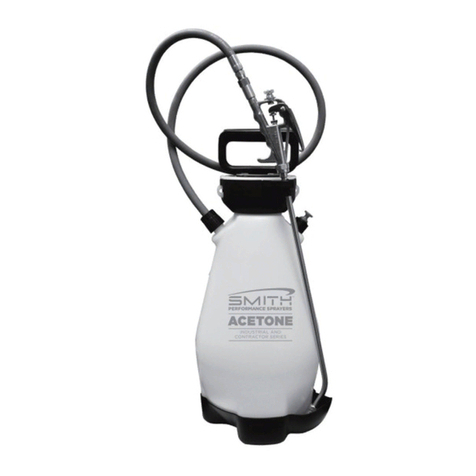
Smith Performance Sprayers
Smith Performance Sprayers Industrial & Contractor Series User manual

Smith Performance Sprayers
Smith Performance Sprayers Industrial & Contractor Series User manual
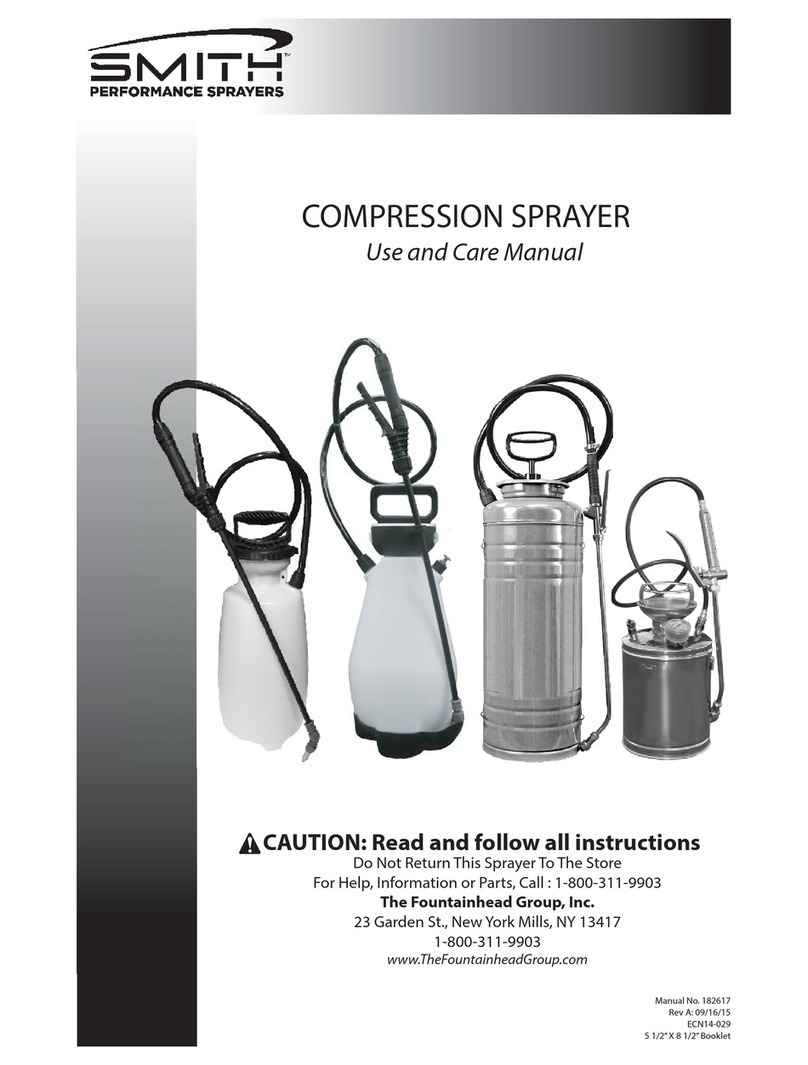
Smith Performance Sprayers
Smith Performance Sprayers PERFORMANCE S100 User manual
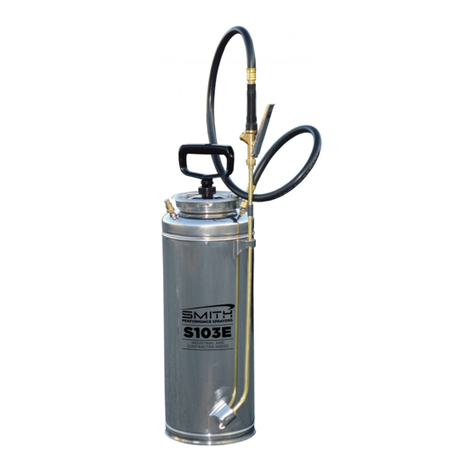
Smith Performance Sprayers
Smith Performance Sprayers S103E User manual

Smith Performance Sprayers
Smith Performance Sprayers S103EX User manual
